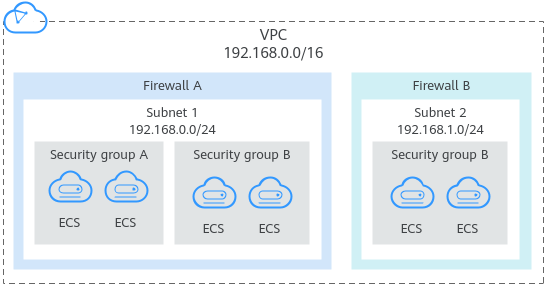Differences Between Security Groups and Firewalls¶
You can configure firewall and security group rules to protect the instances in your VPC, such as ECSs and databases.
A security group protects the instances in it.
A firewall protects associated subnets and all the resources in the subnets.
For details, see Figure 1.

Figure 1 Security groups and firewalls¶
Table 1 describes the differences between security groups and firewalls.
Category | Security Group | Firewall |
|---|---|---|
Protection Scope | Protects instances in a security group, such as ECSs and databases. | Protects subnets and all the instances in the subnets. |
Rules | Does not support Allow or Deny rules. | Supports both Allow and Deny rules. |
Matching Order | If there are conflicting rules, they are combined and applied together. | If rules conflict, the rule with the highest priority takes effect. |
Usage |
| Selecting a firewall is not allowed when you create a subnet. You must create a firewall, add inbound and outbound rules, associate subnets with it, and enable firewall. The firewall then protects the associated subnets and instances in the subnets. |
Packets | Packet filtering based on the 3-tuple (protocol, port, and source/destination) is supported. | Packet filtering based on the 5-tuple (protocol, source port, destination port, and source/destination) is supported. |